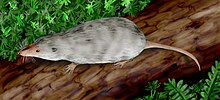
Back Mammaliaformes Afrikaans ثدييات الشكل Arabic ثدييات الشكل ARZ Mamaliaformes Catalan Mammaliaformes English Mamuloformaj Esperanto Mammaliaformes Spanish Mammaliaformes Basque پستاندارسانها Persian Mammaliaformes Finnish
| Mammaliaformes Temporal range: Upper Triassic–Recent
| |
|---|---|

| |
| Adelobasileus | |
| Scientific classification | |
| Domain: | Eukaryota |
| Kingdom: | Animalia |
| Phylum: | Chordata |
| Clade: | Synapsida |
| Clade: | Therapsida |
| Clade: | Cynodontia |
| Clade: | Epicynodontia |
| Clade: | Eucynodontia |
| Clade: | Probainognathia |
| Clade: | Chiniquodontoidea |
| Clade: | Prozostrodontia |
| Clade: | Mammaliamorpha |
| Clade: | Mammaliaformes Rowe, 1988 |
Mammaliaformes ("mammal-like") is a clade which contains the mammals and their closest extinct relatives.[1]
Living members of the clade include the monotremes (Monotremata), marsupials (Marsupialia) and the eutherians (Placentalia).[2][3]
Mammaliforms have highly specialized molar teeth, with cusps and flat regions for grinding food. This is a single inherited system in present mammals, but it seems to have evolved convergently in pre-mammals more than once.[4] Instead of having many teeth that are frequently replaced, mammals have one set of baby teeth and later one set of adult teeth which fit together precisely. This may help to grind food, and make it easier to digest.
Lactation (milk) and fur, along with other features, also characterize the Mammaliaformes, though these traits are difficult to study in the fossil record. The fossilized remains of Castorocauda lutrasimilis are an exception to this.
- ↑ Rowe T.S. 1988. Definition, diagnosis, and origin of Mammalia. Journal of Vertebrate Paleontology 8 (3): 241–264. doi:10.1080/02724634.1988.10011708.
- ↑ Kielan-Jaworowska, Zofia; Cifelli, Richard L. and Luo, Zhe-Xi 2004. Mammals from the age of dinosaurs. Columbia N.Y. ISBN 0-231-11918-6
- ↑ Kemp T.S. 2005. The origin & evolution of mammals. Oxford University Press.
- ↑ Hunter J.P. & Jernvall J. 1995. The hypocone as a key innovation in mammalian evolution. Proc. Natl. Acad. Sci. U.S.A. 92 (23): 10718–22. doi:10.1073/pnas.92.23.10718. PMC 40683. PMID 7479871.